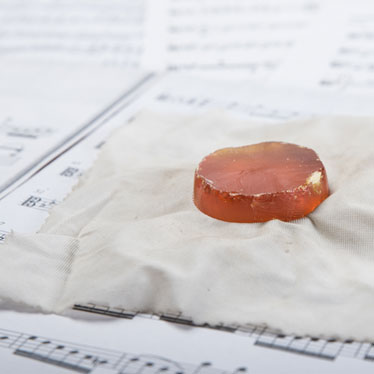What You Need To Know About Rosin For Your Cello Bow

Rosin is an important string instrument accessory. It's a catalyst between the bow and cello strings, creating the "just right" amount of friction to produce smooth, consistent, and resonant sound. Too much rosin means the bow won't move smoothly, and the sound is raspy; too little rosin and sounds are faint, hollow, and inconsistent.
Over time, you'll find rosin balance. For now, here are things worth knowing about rosin and your cello bow.
Rosin is a composite made of tree sap and other ingredients
That's right. Rosin really does grow on trees, or at least in them. It's a composite formula made from heating and purifying sap from pine trees, then mixing it with other ingredients to customize the look and texture. As with any string instrument accessory, there are variations in quality. While you don't need to invest in professional grade rosin, it is important that you purchase higher-quality cello rosin to protect the integrity of your cello bow and the strings.
Rosin is made in a variety of thicknesses and textures to accommodate your instrument; usually, the bigger the instrument, the darker and softer the rosin is to increase traction. However, other factors such as temperature and humidity play a part in rosin preferences.
Read, What is Rosin and How to Choose the Best One for Your Bow, to learn more about how rosin works.
Use rosin made for cellos
So your best friend just quit and offered you his leftover supply of violin rosin. That's great, right? Actually - it's not so great because most violin and viola rosin is different from cello and bass rosin. Typically, violin rosin is lighter in color, and harder (less sticky) in texture - offering just enough friction for its designated instrument. An exception to this rule is Magic Rosin, an extra special rosin that is completely clear and used for violins, violas and cellos. Cellists prefer the Ultra version that is grippier than the 3G formula made for violin and viola.
As a cellist, you need rosin designed for cellos and bass players. This darker, softer rosin is a little stickier, making it easier for your larger bow to gain traction on thicker strings. If you were to take your generous friend up on his offer, your sound quality would suffer and the effort you'd need to exert in order to play correctly could lead to overuse injuries - or find you overcompensating for the rosin's lack of friction.
Once you move into the intermediate-advanced category and begin trying out different cello strings, pay attention to the manufacturer's recommendations. Certain rosins work better with certain string-types, and these variations change how playing feels and sounds.
Magic Rosin is a fun, affordable and superior quality rosin for cellists and violinists - plus it comes in a variety of fun colors and designs. It’s specifically formulated for a less-is-more approach, so musicians need only swipe the bow 2-3 times across its surface to achieve optimal coverage and effect. Most cellists find they can even go a practice session or two before needing to reapply it. Although Magic Rosin comes in a stunning array of colors, graphics and holograms, you can also customize yours using your favorite photos, graphics or logos.
Apply rosin correctly
Beginning students are notorious for over-applying rosin. However, reigning in the enthusiasm and applying only as much as you need pays off in terms of better sound and technique.
- Apply rosin after tightening the bow hair (without over-tightening)
- Hold the rosin, face-up, in the left-hand and place the strings at the frog of the bow flat on the rosin's surface.
- Gently pull the bow along the rosin until you reach the tip, and then push it gently back again. It's like a slow scrubbing motion and you repeat this along the entire length of the bow as directed by the rosin’s manufacturer. In the case of Magic Rosin, two to three times suffices; other rosins may require more pass-throughs.
Your instrument will tell you when you need more rosin (usually not more than once-per-practice for beginners). It will sound lighter and fainter if there isn't enough rosin, scratchy and raspy if there's too much.
Is your rosin good for you?
Some people are more sensitive to rosin particulate matter than others. For example, if you're allergic to pine trees - or a specific species of pine - you may find yourself sneezing regularly if you (or others) get too enthusiastic about rosining their bows. Those with more heightened sensitivities experience contact dermatitis - a rash that develops wherever rosin makes contact with your skin.
Then, as mentioned above, certain brands of rosin have proprietary ingredients that are added to the pine sap mixture during production, so you could find you're sensitive to those ingredients - including metals, essential oils or powders. First, start out with an all-natural rosin, minus the additives. This is a safe bet for most.
Then, use best-application practices to minimize your contact (and inhalation) of rosin dust:
- Use rosin sparingly - there's no need to overdo it. Move your bow slowly across the rosin, rather than vigorously, to minimize dust.
- Wipe your instrument down after playing (minimizes dust and also protects the instrument's finish).
- Clean the strings with a dry cloth to prevent rosin build-up on and around strings.
- Keep your instrument and bow stored in a case, and give the case a good clean with a vacuum attachment every week or so to suck up excess rosin dust and miscellaneous debris.
Developing good rosin habits enhances your playing experience, from the smooth, free motion required for healthy bowing to the production of better sounds.


